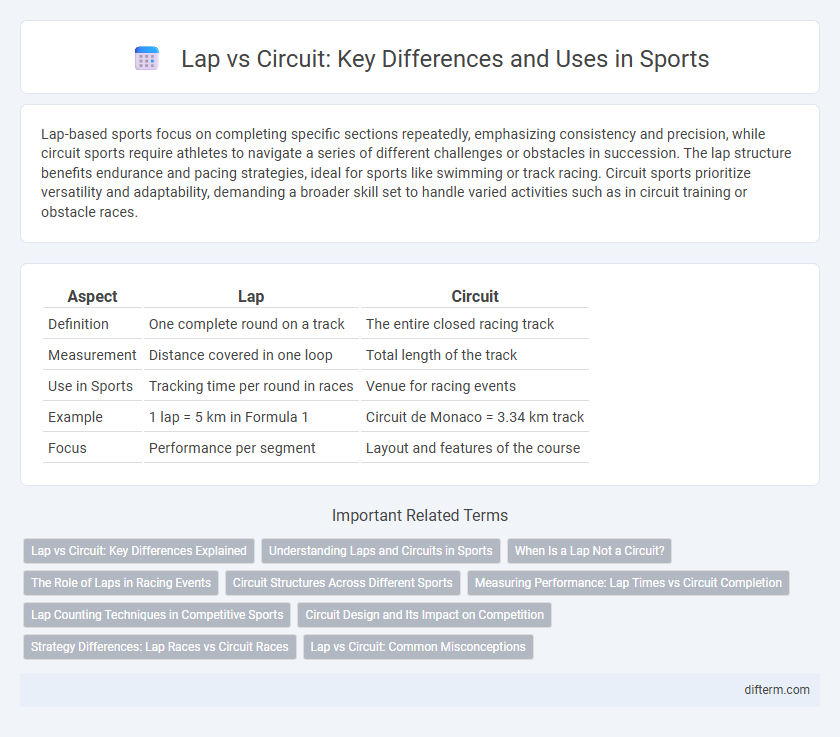Lap-based sports focus on completing specific sections repeatedly, emphasizing consistency and precision, while circuit sports require athletes to navigate a series of different challenges or obstacles in succession. The lap structure benefits endurance and pacing strategies, ideal for sports like swimming or track racing. Circuit sports prioritize versatility and adaptability, demanding a broader skill set to handle varied activities such as in circuit training or obstacle races.
Table of Comparison
| Aspect | Lap | Circuit |
|---|---|---|
| Definition | One complete round on a track | The entire closed racing track |
| Measurement | Distance covered in one loop | Total length of the track |
| Use in Sports | Tracking time per round in races | Venue for racing events |
| Example | 1 lap = 5 km in Formula 1 | Circuit de Monaco = 3.34 km track |
| Focus | Performance per segment | Layout and features of the course |
Lap vs Circuit: Key Differences Explained
A lap refers to one complete traversal around a track or course, while a circuit encompasses the entire race layout including multiple laps and specific segments. In motorsports, a circuit is the designed route featuring straights, corners, and chicanes, and a lap is each iteration of completing that route. Understanding the distinction between lap and circuit is crucial for comprehending race formats, strategies, and timing metrics.
Understanding Laps and Circuits in Sports
A lap refers to a single complete pass around a race track or course, while a circuit denotes the entire race path or track itself, often consisting of multiple laps. In sports like track cycling, motorsports, and running, understanding laps helps in measuring distance covered, while circuits define the race structure and challenge. Differentiating laps from circuits is crucial for strategizing pacing, assessing performance, and adhering to competition rules.
When Is a Lap Not a Circuit?
A lap refers to a single complete traversal around a track, while a circuit encompasses the entire race event or series of laps on a specific course. A lap is not a circuit when it represents just one segment of multiple laps needed to finish a race or session, such as in Formula 1 or NASCAR events. The distinction is crucial for understanding race timing, strategy, and performance analysis in professional sports.
The Role of Laps in Racing Events
Laps serve as fundamental units of measurement in racing events, defining the course length and structuring the competition. Each lap completed contributes to the overall race distance, with racers aiming to achieve the fastest cumulative time or accumulate the highest number of laps within a set duration. Monitoring lap times enables precise performance analysis and strategic decisions critical to race outcomes.
Circuit Structures Across Different Sports
Circuit structures vary significantly across sports, with Formula 1 featuring intricate road courses combining high-speed straights and technical corners, while cycling circuits often incorporate repetitive loops on relatively flat terrain for endurance testing. In athletics, track and field circuits are standardized oval tracks of 400 meters, designed for consistent lap measurement and athlete pacing. Motorsports like MotoGP blend natural terrain and artificial track elements to challenge riders with elevation changes and varying corner types.
Measuring Performance: Lap Times vs Circuit Completion
Lap times provide precise measurements of an athlete's speed and consistency during individual segments of a race, allowing for targeted performance analysis and improvement. Circuit completion, on the other hand, evaluates overall endurance and strategy by encompassing all laps within a race, reflecting sustained performance under varying conditions. Tracking both lap times and circuit completion offers a comprehensive assessment of athletic capability and race execution.
Lap Counting Techniques in Competitive Sports
Lap counting techniques in competitive sports utilize electronic timing systems and RFID tags to ensure accurate measurement of each athlete's progress around the circuit. Sensors embedded in the track detect when a competitor completes a lap, minimizing human error and enhancing fairness in races. Advanced software integrates real-time data to monitor lap times, optimize performance, and provide precise race analytics.
Circuit Design and Its Impact on Competition
Circuit design profoundly influences race dynamics by shaping speed, overtaking opportunities, and safety standards. Variations in track length, corner complexity, and elevation changes create distinct lap challenges that test driver skill and vehicle performance. Strategic layout decisions impact competition intensity, lap times, and overall race outcomes, highlighting the critical role of circuit engineering in sports racing.
Strategy Differences: Lap Races vs Circuit Races
Lap races emphasize endurance and consistent pacing, requiring athletes to manage energy reserves across repetitive loops. Circuit races involve varied terrain and elevation changes demanding adaptive strategies and precise technical skills for each segment. Strategic planning differs as lap races favor steady rhythm, while circuit races prioritize maneuvering complex course features to gain advantage.
Lap vs Circuit: Common Misconceptions
A lap refers to one complete trip around a race track, while a circuit denotes the entire layout or configuration of the track itself. Common misconceptions arise when people use laps and circuits interchangeably, but laps measure distance covered during a race, whereas circuits represent the specific track design. Understanding this distinction is crucial for accurate commentary and analysis in motorsports and athletics.
lap vs circuit Infographic

 difterm.com
difterm.com